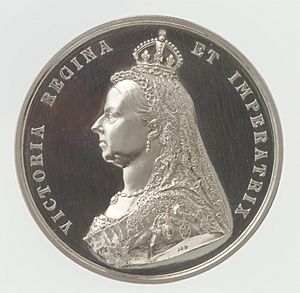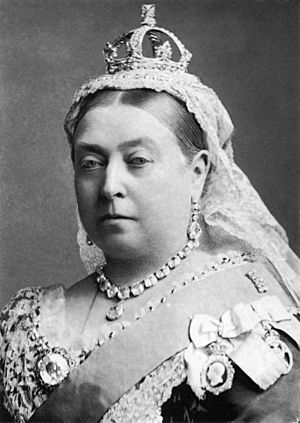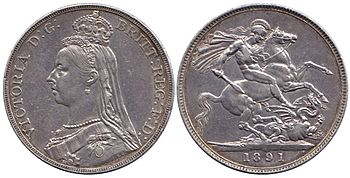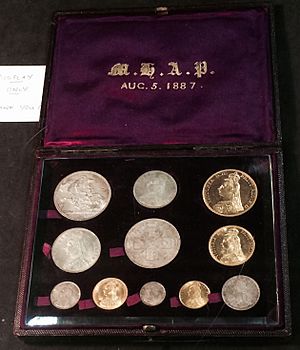Double florin facts for kids
| United Kingdom | |
| Value | £0.2 |
|---|---|
| Mass | 22.6 g |
| Diameter | 36 mm |
| Edge | Milled |
| Composition | 92.5% silver |
| Silver | 0.6727 troy oz |
| Years of minting | 1887–1890 |
| Catalog number | KM 763 |
| Obverse | |
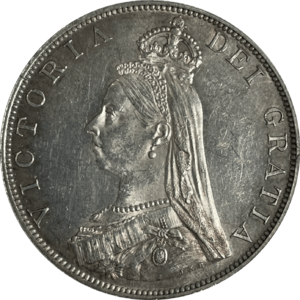 |
|
| Design | Profile of Queen Victoria |
| Designer | Joseph Boehm |
| Design date | 1887 |
| Reverse | |
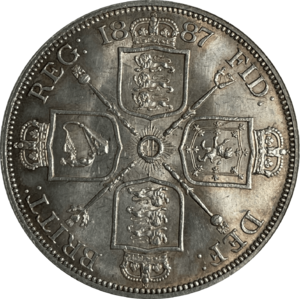 |
|
| Design | Crowned shields and sceptres |
| Designer | Leonard Charles Wyon |
| Design date | 1887 |
The double florin was a British coin made by the Royal Mint. It was also called the four-shilling piece. This coin was only made for four years, from 1887 to 1890. This makes it one of the shortest-lived British coins ever.
The front (called the obverse) of the coin showed Queen Victoria. This design was created by Joseph Boehm and engraved by Leonard Charles Wyon. The back (called the reverse) showed symbols of the United Kingdom. Wyon designed the back, inspired by older coins from the time of King Charles II.
The double florin was part of a big coin redesign in 1887. This was the year of Queen Victoria's Golden Jubilee, celebrating 50 years on the throne. One goal was to update Victoria's image on coins. The old pictures showed her as a young woman, but she was almost 70 years old by then. Officials also wanted to use fewer expensive gold coins. They hoped the double florin (worth four shillings) and the crown (worth five shillings) would help. They might also have wanted to move closer to a decimal money system. This system uses units of ten, like the florin (two shillings, or one-tenth of a pound) introduced in 1849.
When the new coins came out in June 1887, people were not happy. The small crown on Victoria's head on Boehm's design caused a lot of jokes. The double florin was especially disliked. It was very similar in size to the five-shilling crown. This led to a lot of confusion, especially since neither coin had its value written on it. People said this confusion was worst in pubs. Barmaids often mistook the double florin for a crown. This earned the coin nicknames like "Barmaid's Ruin" or "Barmaid's Grief". The coin stopped being made after 1890. However, it stayed in use. When Britain fully switched to decimal money in 1971, the double florin was still valid. It is still legal tender today for 20p (which is £0.20).
Contents
Why Was the Double Florin Made?
Old Money System and New Ideas
In the 1800s, Britain used a money system with 12 pence in a shilling and 20 shillings in a pound. People were interested in changing to a decimal system. In 1849, the florin was introduced. It was worth two shillings, or one-tenth of a pound. This was a first step towards decimal money.
The florin was meant to replace the half crown, which was worth two shillings and sixpence. The half crown stopped being made in 1850. But it started again in 1874. Both coins were used until Britain went fully decimal in the 1970s. The crown, or five-shilling coin, was not made for everyday use between 1847 and 1887.
Problems with Gold Coins
The next biggest coin was the gold half sovereign, worth ten shillings. This was a small coin, the same size as the silver sixpence. Some people would cover sixpences in gold to make them look like half sovereigns. This was a problem.
Gold coins like the sovereign and half sovereign had to contain their full value in precious metal. This rule was very strict. Because of this, many newly made half sovereigns were rejected by machines at the Royal Mint. This made them expensive to produce. The government made money from silver coins because their metal value was less than their face value. This was called seignorage. But gold coins were different. The half sovereign was costly to make and its metal was valuable.
In 1886, a politician named Lord Randolph Churchill suggested getting rid of the half sovereign. He thought it was an "expensive and unnecessary" coin. He wanted to replace it with larger silver coins. The governor of the Bank of England, James Currie, then suggested a double florin. This would help people make change if the half sovereign was gone.
Lord Randolph Churchill resigned before this plan was fully decided. His replacement, George Goschen, decided not to stop making the half sovereign. However, no half sovereigns were made at the Royal Mint's main facility for almost three years after June 1887.
Why More Silver Coins?
Some people wanted to use more silver for coins. They believed in bimetallism, a system where both gold and silver are official money. Increasing silver coinage was a step towards this idea. This was important because of problems in British India. The Indian government received money in silver but had to pay Britain in gold. The value of silver was falling compared to gold. More silver coins in Britain could help India financially.
No clear document explains exactly why the double florin was created. But experts believe it was to use less of the costly half-sovereign. This would save gold and increase the demand for silver. Both were good goals at the time. One historian called the double florin "a half-hearted concession to admirers of the decimal system."
Some also hoped the double florin, as a large silver coin, would be used for trade in the Far East. It was similar in size to the Mexican "dollar". However, the double florin was worth less than the Mexican coin. Only a small number of double florins were sent abroad.
Coin Design
The Front (Obverse)
By 1887, Queen Victoria had been queen for 50 years. She was almost 70 years old. But British coins still showed her as a young woman, just like they had since 1838. Her Golden Jubilee in 1887 was a chance to put new designs on coins. Almost all circulating coins got a new portrait of her that year.
In 1879, Joseph Boehm was chosen by Queen Victoria herself to create her portrait for coins. Boehm made a likeness that was used for a medal celebrating the Jubilee. Leonard Charles Wyon then adapted this design for the coins. He made small changes and lowered the relief (how much the image sticks out).
The front of the new Jubilee coinage, including the double florin, featured this new portrait. It quickly became very unpopular. Even though Victoria had posed for Boehm, people disliked the image. One expert said the design "produced a storm of disapproval." Historian Sir Charles Oman called the Jubilee coinage "the greatest disappointment of the century."
Victoria wears a small crown in the portrait. She had bought this crown because it was lighter than her official one. It was the crown she preferred to wear at that time. It appears in other pictures of her from that period. Some people thought the portrait looked fine if you covered the crown. The problem was the "ridiculously small crown."
The historian Simon Heffer said the engraving was "honest and lifelike." But he added that Victoria "looked sour, chinless and porcine." Her head seemed too big, and the tiny crown made it look even stranger. The art critic George Moore joked that the coins would end up in the "melting-pot" someday.
Besides the crown, Victoria's head also has a widow's veil. After her husband, Albert, Prince Consort, died in 1861, she wore black mourning clothes. The veil would have been black. It comes down from a widow's cap under her crown. The queen also wears a pearl necklace and an earring. You can see the Ribbon and Star of the Order of the Garter and the badge of the Order of the Crown of India. The artist's initials, JEB, are on her bust.
The Back (Reverse) and Words
The back of the coin has four shields arranged like a cross. Sceptres are placed between them. This design was based on older coins from the time of King Charles II. The shields show the arms of the United Kingdom. The top and bottom shields are for England. The one on the right is for Scotland, and the one on the left is for Ireland. One writer, Gertrude Rawlings, jokingly described the design as "radiating kitchen pokers and tea trays."
Around the edge of the double florin are shortened versions of Queen Victoria's titles. The date is also on the back. The front says "VICTORIA DEI GRATIA" (Victoria by the Grace of God). The back continues with "BRITT: REG: FID: DEF:" (Queen of the Britains, Defender of the Faith). "Britains" here means the colonies and other lands. The title "Empress of India" (IND: IMP:) is not on this coin. A law from 1876 said she could not use that title within the United Kingdom. Victoria wanted that title on British coins, and it appeared on later coins starting in 1893.
Like other coins made in June 1887, the double florin did not say its value. By 1889, even the Queen herself disliked the new coins. She wrote that she wished the old coins could still be used. In 1891, the Mint held a competition for new coin designs. The winning design by Thomas Brock was used on coins starting in 1893. These new coins, including the sixpence and half crown, did have their value written on them.
Coin Production and End
Making and Stopping the Coin
In December 1887, a Mint official wrote that the reasons for making the double florin were "very complicated." He doubted it would be popular. In May 1888, a newspaper reported that almost £100,000 worth of double florins had been made, but most had "disappeared." The coin had not become popular.
There was a lot of confusion between the double florin and the crown. This is why the four-shilling coin was nicknamed "Barmaid's Grief." Barmaids often mistook the double florin for the larger crown. The double florin and the crown were only 2 millimeters different in size. Some stories say barmaids lost their jobs because of this "Barmaid's Ruin." The Banker's Magazine wrote in 1890 that few people, even experienced cashiers, could easily tell the two coins apart.
The year 1889 saw the most double florins made, over a million. The government used these large coins to pay its employees. It also had an agreement with the Bank of England to help distribute silver coins. In March 1890, George Goschen, a government official, told Parliament that there was "hardly any similarity" between the double florin and the crown. People in Parliament disagreed loudly. In May, he said it was too early to decide if the coin should be stopped.
However, the Royal Mint stopped making the double florin in August 1890. According to coin expert Richard Lobel, the coin was "unpopular at the time of issue." He believes the disliked portrait of Queen Victoria probably made it stop being used faster. Sir John Craig, a historian of the Royal Mint, said the coin's similarity to the 5-shilling piece, its size, and its newness were big problems. The coin was so unpopular that the Mint took back the coins at their full value if people asked.
What Happened Next
Joseph Boehm, the designer of the Queen's portrait, died in December 1890. Some believed the strong criticism of his coin design made him ill. Leonard Charles Wyon, who engraved the design, died the following August. A coin expert wrote that Wyon was very disappointed that Boehm's design was chosen for the 1887 coins. This disappointment might have "hastened his end."
In February 1891, a committee was set up to look at coin designs. At its first meeting, the committee decided the double florin should be stopped. This was confirmed by Goschen in May. The committee's report in 1892 also recommended that the double florin not be kept. In January 1893, The Daily Telegraph newspaper wrote that the double florin had been disliked by everyone.
By 1914, about 70 percent of the double florins had been taken out of circulation. But some still remained. A 1931 report said the double florin was the only old coin still used in Britain, but it was "rarely seen." Even after silver coins stopped being made in 1946, some double florins were found when the Royal Mint recovered silver in the 1960s. The idea of bringing back the double florin was considered sometimes.
The double florin was not made invalid when Britain switched to decimal money in 1971. It is still legal tender today for 20p (£0.20).
Collecting Double Florins
Since the double florin was only made for four years, it is popular for collectors to try and get a complete set. There are a few different types (called varieties) of these coins.
- The first coins had a flat front and back.
- Later, a second version of the front and back was used. These had slight differences and a slightly curved surface. These were used for some 1887 coins and in later years.
- The date "1887" was first written with a Roman numeral I (I887). This was changed to an Arabic number 1 even before the back design changed.
- On some 1888 and 1889 coins, the second "I" in "VICTORIA" looks like an upside-down Arabic number 1.
- The design on the back was made a bit bigger for the 1890 coins.
Proof coins (special, high-quality coins made for collectors) exist for 1887. Some have the first flat designs and the Roman I. Others have the second, slightly curved designs and the Arabic 1.
A coin grading service called the Numismatic Guaranty Company says that most regular double florins are worth about $15.50 (their metal value) in good condition. But in almost perfect condition, they can be worth between $400 and $750. The 1887 proof coins are worth even more.


